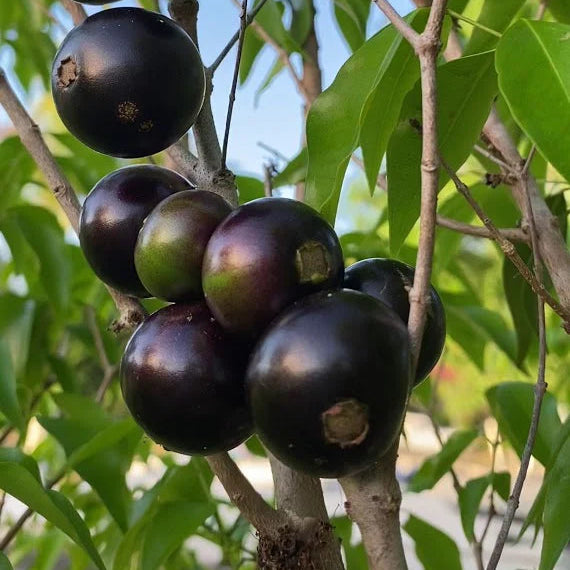Love it? Add to your wishlist
Your favorites, all in one place. Shop quickly and easily with the wishlist feature!
[message]
[title]
[message]



Veliyath Gardens
Couldn't load pickup availability
A Rare Jewel of the Myrtaceae Family for Exotic Fruit Lovers
The Crowned Jaboticaba is one of the most captivating members of the Myrtaceae family, admired for its striking fruits, unique crown-like calyx, and delightful tropical flavor. Native to the Atlantic Forest regions of Brazil, this rare species is treasured by collectors, hobbyists, and fruit connoisseurs. Its unusual appearance and high pulp content make it an exceptional addition to exotic and container gardens.
Botanical Name: Plinia coronata
Common Names: Crowned Jaboticaba, Restinga Jaboticaba
Family: Myrtaceae — the same family as guava, camu camu, Surinam cherry, and eucalyptus
Plants in the Myrtaceae family are well-known for their aromatic foliage, high-antioxidant fruits, and adaptability to humid climates. The Crowned Jaboticaba stands out with its trunk-hugging fruits and ornamental foliage, making it valuable both horticulturally and gastronomically.
The plant forms a compact, dense structure with attractive reddish-brown bark that peels with age. Its most remarkable feature is the way the fruits develop — directly on the trunk and older branches, a phenomenon known as cauliflory.
Growth Characteristics:
Type: Shrub to small tree
Height: Usually 3–6 meters in cultivated settings
Canopy: Rounded and symmetrical
Growth Rate: Moderate
Lifespan: Long-lived with proper care
The pronounced “crown” at the fruit’s sepal can vary significantly in size, lending the plant its distinctive name.
Though seed-grown trees may take longer, grafted and well-maintained plants reward growers with multiple harvests yearly once established.
Fruiting Information:
Time to Fruit from Seed: 6–7 years
Early Fruiting (with care): As little as 2–5 years
Fruiting Frequency: Multiple crops per year in ideal climates
Pulp Content: Over 60% by weight
Skin Color: Deep purple to almost black
Flavor: Similar to Sabara Jaboticaba with floral, bubblegum, and root beer undertones
The fruits are smooth, glossy, and filled with juicy pulp, making them perfect for both fresh consumption and value-added preparations.
The Crowned Jaboticaba is prized not only for its novelty but also for its versatility in the kitchen.
Taste Profile:
Sweet with mild acidity
Floral and fruity notes
Subtle hints of candy, root beer, or rosewater at peak ripeness
Culinary Uses:
Fresh eating right off the tree
Juices and smoothies
Jellies, jams, and preserves
Fermented beverages and wine
Ice creams, syrups, and desserts
Its melt-in-the-mouth pulp makes it an exciting fruit for chefs and home cooks alike.
Like many Myrtaceae fruits, Crowned Jaboticaba is nutrient-dense and traditionally used to support wellness.
Key Benefits Include:
Respiratory Wellness: Traditionally used to ease asthma and congestion
Anti-Inflammatory Effects: Helps reduce chronic inflammation
Skin & Hair Care: Promotes collagen health and growth
Antioxidant Power: Fights cellular damage and may aid in cancer prevention
Heart Support: Assists in maintaining balanced lipid metabolism
Digestive Strength: Helps control diarrhea and improves gut flora
Bone Reinforcement: Contains minerals vital for skeletal health
The peel is particularly rich in anthocyanins — compounds linked to healthy aging and disease prevention.
The Crowned Jaboticaba thrives in varied conditions when given consistent moisture and nutrition.
Ideal Growing Conditions:
Climate: Tropical to subtropical
Temperature Tolerance: Mild frost resistance in mature plants
Soil: Rich, loamy, and well-draining
Sunlight: Partial shade to full sun
Water: Regular irrigation, especially during flowering and fruiting
Humidity: Prefers moderate to high humidity
Mulching around the base greatly improves root performance and moisture retention.
Though not difficult to grow, Crowned Jaboticaba benefits from thoughtful care.
Care Guidelines:
Watering: Keep soil consistently moist but not waterlogged
Fertilization: Organic composts and slow-release NPK blends during growth phases
Pruning: Light pruning to maintain shape and encourage cauliflorous fruiting
Pests/Disease: Generally resistant, but monitor for scale insects and fungal issues in high humidity
Container Growing: Suitable for pots and terrace gardens when pruned regularly
With moderate maintenance, the plant becomes a long-term fruiting and ornamental investment.
In its native habitat, Jaboticaba fruits are:
Consumed fresh from the tree
Turned into homemade wines and fermented tonics
Used in folk remedies for sore throat, diarrhea, and bronchial issues
Applied topically for skin rejuvenation and wound care
The tree also holds ecological value, attracting native pollinators and birds.
The Crowned Jaboticaba is ideal for:
Rare fruit collectors
Cherry and jaboticaba enthusiasts
Food forests and agroforestry systems
Ornamental edible landscapes
Terrace gardens in large containers
Eco-conscious gardeners
Its compact size, glossy foliage, and trunk-bearing fruits make it both practical and visually enchanting.
The Crowned Jaboticaba (Plinia coronata) is much more than an exotic fruit tree — it is a conversation piece, a nutritious food source, and a botanical showpiece. With its dark, crowned berries, high pulp content, and distinct candy-like flavor, it brings flair and function to gardens. When cared for with consistent irrigation and balanced feeding, it becomes a long-term producer with multiple yearly harvests.
Whether you're building an exotic edible collection, diversifying a cherry plant category, or enhancing the offerings at Veliyath Gardens, the Crowned Jaboticaba stands out as a premium and rewarding addition.
Climate: Tropical to subtropical
Temperature Tolerance: Mild frost resistance in mature plants
Soil: Rich, loamy, and well-draining
Sunlight: Partial shade to full sun
Respiratory Wellness: Traditionally used to ease asthma and congestion
Anti-Inflammatory Effects: Helps reduce chronic inflammation
Skin & Hair Care: Promotes collagen health and growth
Antioxidant Power: Fights cellular damage and may aid in cancer prevention
The Crowned Jaboticaba (Plinia coronata) is much more than an exotic fruit tree — it is a conversation piece, a nutritious food source, and a botanical showpiece. With its dark, crowned berries, high pulp content, and distinct candy-like flavor, it brings flair and function to gardens.




